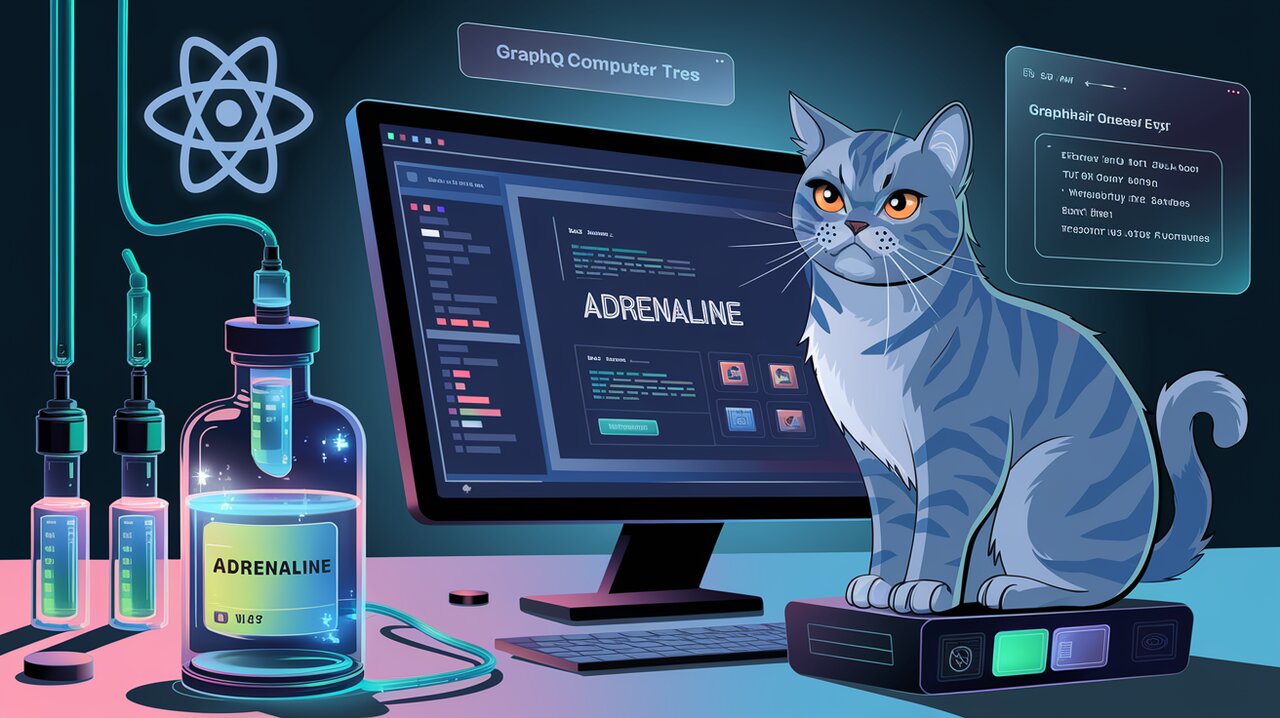
Adrenaline Rush: Supercharge Your React Data Fetching
In the fast-paced world of React development, managing data fetching and state can often feel like a complex juggling act. Enter Adrenaline, a library that promises to simplify this process by providing a subset of Relay’s functionality with a cleaner, more intuitive API. Whether you’re building a small project or a large-scale application, Adrenaline offers a streamlined approach to declarative data requirements that can significantly enhance your development experience.
Pumping Up Your React App with Adrenaline
Adrenaline brings several key features to the table that make it a compelling choice for React developers:
-
Declarative Data Requirements: Define your component’s data needs using GraphQL queries, making it clear what information each part of your UI requires.
-
Container and Presenter Pattern: Separate your data fetching logic from your presentation components, promoting cleaner and more maintainable code.
-
Simple Mutation Handling: Perform GraphQL mutations with ease, updating your application state seamlessly.
-
ES7 Decorator Support: Use modern JavaScript features to create more expressive and concise component definitions.
-
Testing Utilities: Validate your components’ data requirements against your GraphQL schema, catching potential issues early in the development process.
Getting Your Adrenaline Fix
To start using Adrenaline in your project, you’ll need to install it along with its peer dependency, the fetch polyfill. Here’s how you can do it using npm or yarn:
npm install --save adrenaline whatwg-fetch
or
yarn add adrenaline whatwg-fetch
Once installed, you’ll need to import the fetch polyfill at the very top of your entry JavaScript file:
import 'whatwg-fetch';
import React from 'react';
import ReactDOM from 'react-dom';
import { Adrenaline } from 'adrenaline';
import App from './components/App';
ReactDOM.render(
<Adrenaline>
<App />
</Adrenaline>,
document.getElementById('root')
);
Diving into Adrenaline’s Core Concepts
The Adrenaline Provider
At the heart of Adrenaline is the <Adrenaline> component, which serves as a provider for your entire application. It injects the necessary context for Adrenaline to work its magic:
import { Adrenaline } from 'adrenaline';
const App = () => (
<Adrenaline endpoint="/graphql">
{/* Your app components */}
</Adrenaline>
);
The endpoint prop specifies the URI of your GraphQL endpoint, defaulting to “/graphql” if not provided.
Container Components: Your Data Fetching Powerhouses
Container components in Adrenaline are responsible for defining the data requirements of your UI. They act as the bridge between your GraphQL backend and your presentation components.
import React from 'react';
import { container } from 'adrenaline';
import TodoList from './TodoList';
const UserProfile = ({ viewer }) => (
<div>
<h1>{viewer.name}</h1>
<TodoList todos={viewer.todos} />
</div>
);
export default container({
variables: (props) => ({
id: props.userId,
}),
query: `
query ($id: ID!) {
viewer(id: $id) {
id
name
${TodoList.getFragment('todos')}
}
}
`,
})(UserProfile);
In this example, we define a UserProfile component that requires data about a user and their todos. The container higher-order component wraps our presentational component, providing it with the data it needs.
Presenter Components: Keeping It Clean
Presenter components focus solely on rendering UI based on the props they receive. They can define their own data requirements using fragments:
import React from 'react';
import { presenter } from 'adrenaline';
const TodoList = ({ todos }) => (
<ul>
{todos.map(todo => (
<li key={todo.id}>{todo.text}</li>
))}
</ul>
);
export default presenter({
fragments: {
todos: `
fragment on User {
todos {
id
text
}
}
`,
},
})(TodoList);
This separation of concerns allows for more reusable and testable components.
Advanced Adrenaline Techniques
Mutations: Changing Your Data with Ease
Adrenaline makes it simple to perform mutations and update your application state:
import React from 'react';
import { container } from 'adrenaline';
const createTodo = `
mutation ($text: String!, $owner: ID!) {
createTodo(text: $text, owner: $owner) {
id
text
owner {
id
}
}
}
`;
const TodoCreator = ({ mutate, viewer }) => {
const handleSubmit = (event) => {
event.preventDefault();
const text = event.target.elements.todoText.value;
mutate({
mutation: createTodo,
variables: {
text,
owner: viewer.id,
},
});
};
return (
<form onSubmit={handleSubmit}>
<input name="todoText" type="text" />
<button type="submit">Add Todo</button>
</form>
);
};
export default container({
query: `
query {
viewer {
id
}
}
`,
})(TodoCreator);
The mutate function provided by Adrenaline allows you to execute GraphQL mutations and automatically update your UI.
Decorators: Syntactic Sugar for Your Components
If you’re using ES7 decorators, you can make your container components even more concise:
import React from 'react';
import { container } from 'adrenaline';
@container({
query: `
query {
viewer {
id
name
}
}
`,
})
export default class UserGreeting extends React.Component {
render() {
const { viewer } = this.props;
return <h1>Hello, {viewer.name}!</h1>;
}
}
This syntax can make your code more readable and maintainable.
Testing: Ensuring Data Integrity
Adrenaline provides utilities to test your components’ data requirements against your GraphQL schema:
import expect from 'expect';
import TestUtils from 'adrenaline/lib/test';
import schema from './schema';
import UserProfile from './UserProfile';
expect.extend(TestUtils.expect);
describe('UserProfile', () => {
it('has valid data requirements', () => {
expect(UserProfile).toBeValidAgainst(schema);
});
});
This testing approach helps catch potential issues early in the development process, ensuring that your components’ data requirements align with your GraphQL schema.
Wrapping Up Your Adrenaline Journey
Adrenaline offers a compelling alternative to more complex data fetching libraries, providing a balance between functionality and simplicity. By embracing declarative data requirements and a clear separation of concerns, Adrenaline can help you build more maintainable and efficient React applications.
Whether you’re working on a small project or a large-scale application, Adrenaline’s approach to GraphQL integration can streamline your development process. Its simple API, combined with powerful features like easy mutation handling and built-in testing utilities, makes it a valuable tool in any React developer’s toolkit.
As you continue to explore Adrenaline, you’ll likely discover even more ways to optimize your data fetching and state management. So why not give your React applications an adrenaline rush? Dive in, experiment, and see how this library can elevate your development experience to new heights.
